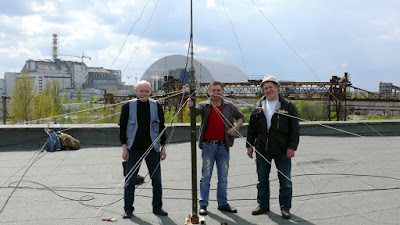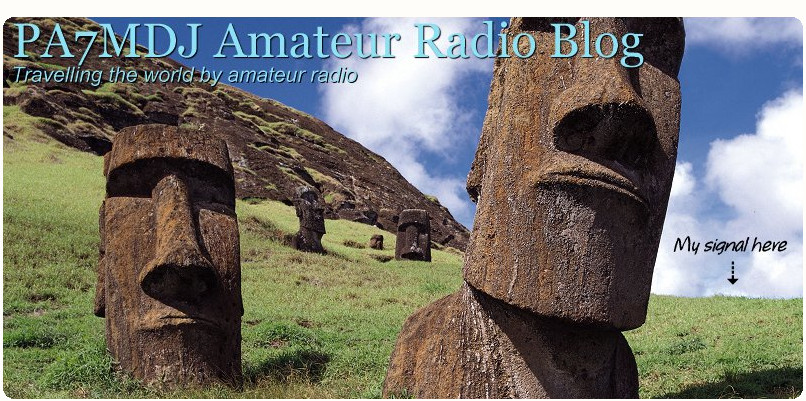On April 26, 2016 it was 30 years ago that the catastrophic nuclear disaster took place at the Chernobyl Nuclear Power Plant in Pripyat, Ukraine (then still part of the former Soviet Union, or USSR). A tragically failed systems test lead to a number of explosions and a huge nuclear leak in "Reactor 4". The accident has been described as the worst nuclear disaster the world has ever seen.
To commemorate the 30th anniversary of the tragic event, last April various amateur radio stations from Belarus, Russia, and Ukraine were active with special callsigns. Some Ukrainian radio amateurs even undertook expeditions to the abandoned towns of Pripyat and Chernobyl, and were active from the Chernobyl Exclusion Zone itself.
The Chernobyl Exclusion Zone, originally extending 30 km in all directions from the damaged reactor, was established by the USSR military soon after the disaster. The evacuated zone is largely uninhabited, except for some residents who refused to evacuate or have resettled. The zone today is controlled by the State Emergency Service of Ukraine, and one of its main purposes today is to restrict access to the hazardous areas around the former Chernobyl power plant. There are checkpoints at the zone's entrances and there are patrols inside the zone and along its perimeter. There's no way of just showing up and entering the area. Some scientists estimate it will take 20,000 years before people can safely live in the Exclusion Zone again. The zone however has been accessible to interested parties like scientists and journalists since its creation, and since 2011 also to interested tourists who wish to learn more about the tragedy, and to which guided Chernobyl tours are offered.
 |
| The Chernobyl Exclusion Zone (source). Note that the Chernobyl Nuclear Power Plant is located in the town of Pripyat, while the town with the name "Chernobyl" is lying roughly 20 km to the southeast of it. |
 |
| A family of moose in Chernobyl's Exclusion Zone (source) |
The following stations were active from the Exclusion Zone:
EN5R on April 25th and 26th, 2016 was active from the ghost town of Pripyat very close to Reactor 4. The photos below show the EN5R team at their QTH in Pripyat on April 25th with the antennas used for their activity. In the background of the first photo you can see Reactor 4 on the left. In the middle you can see the New Safe Confinement structure, which, once completed, will be moved (in fact the New Safe Confinement is a huge rail vehicle) over Reactor 4 to cover it and limit the leaking of more radiation.
 |
| EN5R team in Pripyat (source) |
 |
| EN5R team in Pripyat (source) |
Listen here to a recording of my 20m SSB QSO with EN5R on 26.04.2016.
EM30U was active from the "Pripyat Hotel" in the town of Chernobyl in grid locator KO51cg (URDA KO-26 Kiyv region, Chernobyls'kyi district). I worked EM30U on 30m PSK63 and 20m CW. The resulting QSL card is shown below. For these QSOs I was also credited for URFF-0144 in the WWFF log database. Quite a rare reference to have in the log, I guess.
 |
| EM30U QSL card. At the time of writing, I'm still waiting for the cards to arrive from EN5R and EM7UT. |
EM7UT also was active from the town of Chernobyl in grid locator KO51cg (URDA KO-26). I worked EM7UT in CW and SSB on 40m.
Listen here to a recording of my 40m SSB QSO with EM7UT.
 |
| Grid locator KO51cg as found on http://qthlocator.free.fr/ |
 |
| The now iconic Ferris wheel in ghost town Pripyat, still standing 30 years after the town was abandoned (source). |
See also:
https://en.wikipedia.org/wiki/Chernobyl_Exclusion_Zone
https://en.wikipedia.org/wiki/Chernobyl_disaster
https://en.wikipedia.org/wiki/Pripyat
https://en.wikipedia.org/wiki/Chernobyl
https://en.wikipedia.org/wiki/Chernobyl_New_Safe_Confinement
http://vegcrew.com/chernobyl-history/
http://vegcrew.com/the-zone-today/
http://www.ibtimes.co.uk/chernobyl-disaster-inside-exclusion-zone-abandoned-ghost-town-pripyat-photos-1523628
http://www.telegraph.co.uk/news/2016/04/23/wildlife-returns-to-radioactive-wasteland-of-chernobyl/

No comments:
Post a Comment